
Ongoing Research
Environmental DNA (eDNA) for coastal ecology
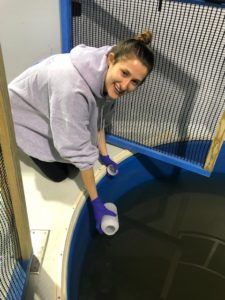
Liz Piotrowski collecting a control eDNA sample from a seal rehab pool at National Marine Life Center.
In collaboration with colleagues at the University of Maine, Bigelow Laboratory for Ocean Sciences, and the Center for Coastal Studies, our lab is contributing to the development and implementation of environmental DNA (eDNA) tools to improve our understanding of coastal ecology and sustainability. eDNA approaches are built on the premise that organisms leave a trace of DNA in the water they inhabit, for example, through sloughed cells, urine, and feces. We can, therefore, extract organismal DNA from a water sample without ever handling, or even seeing, the organism. Such tools have a lot of exciting promise for the non-invasive study of marine mammals, including rare and elusive species. The Cammen Lab established their eDNA lab in summer of 2019, and since then has trialed eDNA extraction for several pinniped and odontocete species.
Genomic ecology of coastal organisms
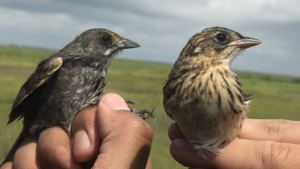
Adult and juvenile seaside sparrow. Photo by MacKenzie Roeder
In collaboration with colleagues at the Universities of Maine and New Hampshire, and supported by an NSF Espcor Track 2 award, we are studying the links between genomes, phenomes, and environment in a system of tidal marsh sparrows. These birds exhibit amazing parallel adaptations to the tidal marsh environment that provide opportunity for study of the genetic mechanisms underlying performance and fitness in harsh environments. We are studying these adaptations with a combination of intense summer field seasons and powerful genomic techniques to elucidate genome-to-phenome links in wild populations.
Disease susceptibility of seals in the Northwest Atlantic
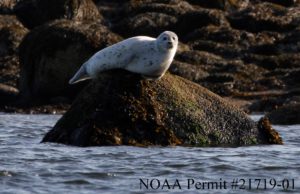
Photo by Lauri Leach
In collaboration with colleagues at the NOAA Northeast Fisheries Science Center, MIT, and WHOI, we are investigating differences in disease susceptibility within and among gray and harbor seals in the North Atlantic. Our region has experienced multiple unusual mortality events attributed to infectious disease epidemics in harbor seals, yet gray seals appear relatively resistant to both phocine distemper virus and influenza A virus. Current approaches to this investigation in our lab include amplicon sequencing MHC Class I and II genes in gray and harbor seals.
Long-term trends in marine mammal stranding rates in Maine
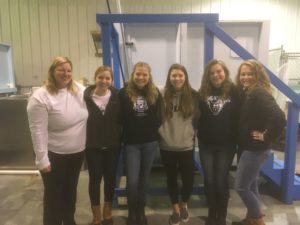
Cammen Lab students visit Lynda Doughty at Marine Mammals of Maine
In collaboration with local marine mammal stranding networks, Marine Mammals of Maine and Allied Whale, we are analyzing long-term datasets on marine mammal strandings throughout the state in order to better understand spatial and geographic trends in marine mammal stranding rates, distribution, and disease.
Pinnipeds on the Penosbscot River
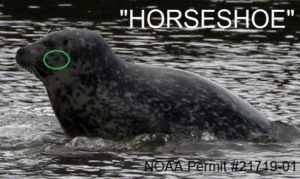
Photo by Lauri Leach
In partnership with the NOAA NEFSC Atlantic Salmon Ecosystems Research Team Gray and Maine DMR, our lab group is studying the ecology of pinnipeds that use the Penobscot River. Following regional recovery of gray and harbor seals, reports of these seals in the Penobscot River have increased. To better understand the potential impacts of pinniped recovery to river systems undergoing dedicated restoration efforts, we are analyzing the seasonal occurrence and distribution of seals in the river, along with data on prey fish abundance and putative seal-induced injury rates to Atlantic salmon. This research is funded by the Maine Outdoor Heritage Fund. To learn more about this project, please check out our Penobscot River pinnipeds page.
Recent Research
Gray and harbor seals: pre-bottleneck to recovery in the Northwest Atlantic
Gray and harbor seals in the Northwest Atlantic have experienced relatively parallel historical population trajectories of decline following human exploitation and subsequent recovery as a result of federal protection and conservation efforts. Within the context of these ‘natural experiments’, we are studying the impacts of bottleneck and recovery on species diversity using genetic and genomic techniques. We aim to compare pre-bottleneck diversity in archaeological specimens to diversity in seal populations today from throughout the Northwest Atlantic. This work has been facilitated by several international collaborations, including with Tim Frasier, Don Bowen, Mike Hammill, the University of Maine’s Department of Anthropology, and NOAA’s Northeast Fisheries Science Center; as well as funding from an NSF Postdoctoral Fellowship in Biology.
Cammen KM, Rasher DB, Steneck RS (2019) Predator recovery, shifting baselines, and the adaptive management challenges they create. Ecosphere. 10: e02579.
Cammen KM, Bowen WD, Hammill MO, Puryear WB, Runstadler J, Wenzel FW, Wood SA, Frasier TR, Kinnison M (2018) Genomic signatures of population bottleneck, recovery, and expansion in Northwest Atlantic pinnipeds. Ecology and Evolution. 8: 6599-6614.
Cammen KM, Vincze S, Heller S, McLeod BA, Wood SA, Bowen WD, Hammill MO, Puryear WB, Runstadler J, Wenzel FW, Kinnison M, Frasier TR (2018) Genetic diversity from bottleneck to recovery in two sympatric pinniped species in the Northwest Atlantic. Conservation Genetics. 19: 555-569.
Bottlenose dolphin susceptibility to red tides
Harmful algal blooms (HABs), or red tides, of Karenia brevis occur almost annually in the Gulf of Mexico and threaten coastal ecosystems, including coastal and estuarine bottlenose dolphin populations. Since 1999, four large-scale bottlenose dolphin die-offs have been associated with these toxic blooms. Interestingly, dolphin populations appear to differ in susceptibility to mortality due to HAB exposure. We used candidate gene and genomic approaches to investigate a genetic basis for this susceptibility in dolphins from central-west Florida, where dolphins appear relatively resistant to HABs, and the Florida Panhandle, where dolphins appear relatively susceptible. The candidate gene approach characterized variation at a family of immune system genes (MHC) and the biological target of the HAB toxin (voltage-gated sodium channels). The genomics approach used restriction site-associated DNA (RAD) sequencing to assess variation at thousands of single nucleotide polymorphisms (SNPs) across the bottlenose dolphin genome.
Cammen KM, Schultz TS, Rosel PE, Wells RS, Read AJ (2015) Genome-wide investigation of adaptation to harmful algal blooms in bottlenose dolphins. Molecular Ecology 24: 4697-4710.
Cammen KM, Wilcox LA, Rosel PE, Wells RS, Read AJ (2015) From genome-wide to candidate gene: An investigation of variation at the major histocompatibility complex in bottlenose dolphins exposed to red tides. Immunogenetics 67:125-133.
Cammen KM, Rosel PE, Wells RS, Read AJ (2014) Lack of variation in voltage-gated sodium channels of common bottlenose dolphins exposed to neurotoxic algal blooms. Aquatic Toxicology 157:150-158.
Harp seal strandings in the Northwest Atlantic
Pagophilic seals, such as harp seals, are indicator species for the health of high-latitude ecosystems experiencing rapid declines in sea ice cover due to climate change. We analyzed the effect of ice cover, in combination with demographics and genetic diversity, on harp seal stranding rates along the eastern coast of the United States. Using microsatellites, we found high overall genetic diversity in the harp seal population and no difference between stranded seals and by-caught seals, which represented the healthy population. Yearly variation in harp seal stranding rates could be partially explained by sea ice cover; a greater number of harp seal strandings, particularly of male yearlings, occurred in years with low sea ice cover.
Soulen BK, Cammen KM, Schultz TF, Johnston DW (2013) Factors affecting harp seal (Pagophilus groenlandicus) strandings in the Northwest Atlantic. PLoS ONE 8:e68779.
Invited guest blog for the Smithsonian Ocean Portal.
MHC variation in Eastern Atlantic gray seals
Gray seal breeding colonies experience high levels of pup mortality due to infection. We investigated geographic variation in an immune system gene, the major histocompatibility complex (MHC), among gray seal breeding colonies around the United Kingdom and found patterns of variation consistent with habitat-specific selection on the MHC in gray seals. Mortality rates in gray seals vary among breeding colony habitat types (e.g., sandy beaches vs. inland pools), which suggests environmental variation in pathogen pressure that may drive local immunogenetic adaptation.
Cammen KM, Hoffman JI, Knapp LA, Harwood J, Amos W (2011) Geographic variation of the major histocompatibility complex in Eastern Atlantic grey seals. Molecular Ecology 20:740-752.


